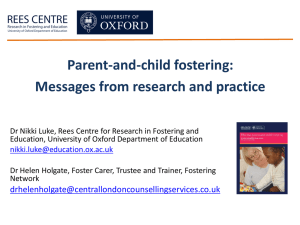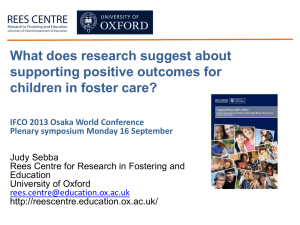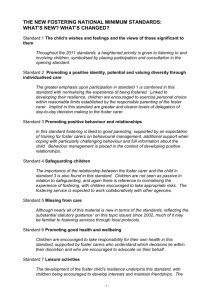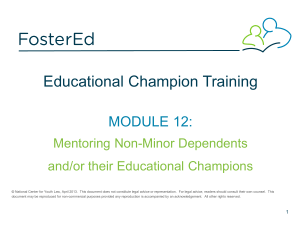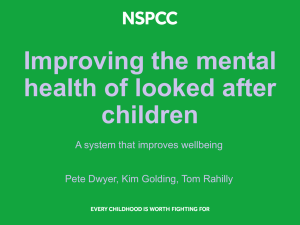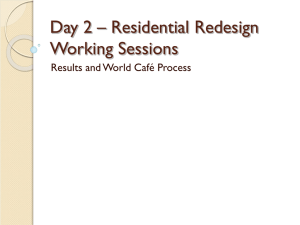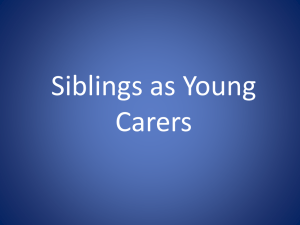Rees Centre for Research in Fostering and Education
advertisement
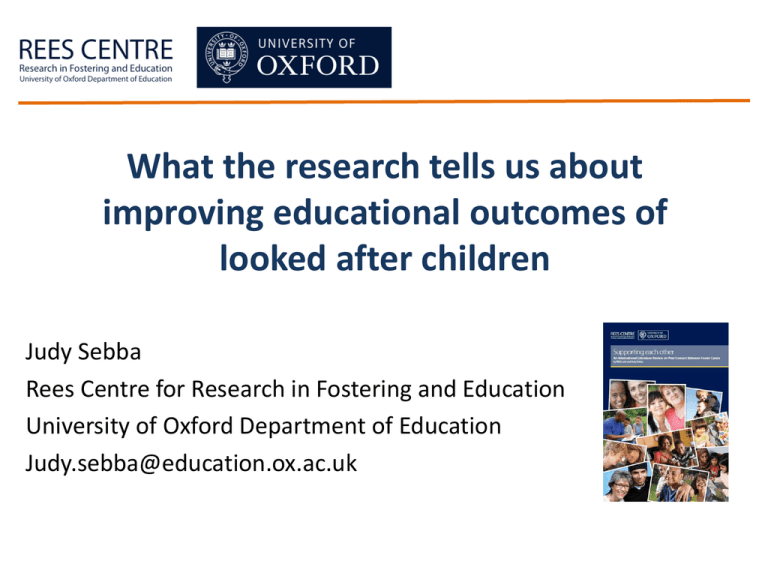
What the research tells us about improving educational outcomes of looked after children Judy Sebba Rees Centre for Research in Fostering and Education University of Oxford Department of Education Judy.sebba@education.ox.ac.uk What I will cover The aims of the Rees Centre Context for looked after children in England What does the evidence tell us about how we can better support educational outcomes of looked after children? • International research • Rees Centre research What schools and fostering services can do to progress this Rees Centre for Research in Fostering and Education The Rees Centre aims to: • identify what works to improve the outcomes and life chances of children and young people in foster care We are doing this by: • reviewing existing research in order to make better use of current evidence • conducting new research to address gaps • working with service users to identify research priorities and translate research messages into practice • employing foster carers and care experienced young people as co-researchers Centre is funded by the Core Assets Group Provision for children in care in England • • • • • 68,110 children in care; 50,260 (75%) in foster care, 6% are in kinship care; 9% in children’s homes, secure units & hostels; 4% placed for adoption; 12% other includes residential (special) schools; • 32% fostered children placed outside of their area; • 39% of fostered children are placed by independent providers; • Virtual school function becomes statutory, Pupil Premium Plus of £1900. Reasons for child placement (source DfE, 2012) Unacceptable behaviour 2% Family dysfunction 14% Acute family stress 9% Parent illness or disability 4% Child disability 3% Absent parenting 5% Abuse or neglect 62% Some outcomes of children in care in England • 15% achieve expected grades at 16 years compared to 58% of all children – a gap of 43%; • achievement gap is lower at KS2 (26% for Maths, 23% reading, 28% writing); • Two times as likely to be permanently excluded; • Three times as likely to have a fixed term exclusion; • Only 8% access HE compared to > 50% of general population; • educational experiences and outcomes contribute to later health, employment (22% unemployment rate), involvement in crime (27% of those in prison). DfE (2013) Statistical First Release 11 Dec 2013 11 The longer in care, the better the performance (source DfE, 2013) 45 40 Percentage achieving 35 30 5+ GCSEs at grades A*-C 25 20 15 5+ GCSEs at grades A*-c including English and mathematics 10 5 0 12 to 18 18 months months to 2 years 2 to 3 years 3 to 4 years 4 to 5 years Length of time in care 5 to 6 years 6 years or more 10 The fewer changes in placement, the better the performance (source DfE, 2013) Key Stage 4 attainment for looked after children by stability in year 45 Percentage achieving 5+ A*-C grades 40 35 30 25 20 15 10 5 43% 29% 20% 13% 1 2 3 More than 3 0 Number of placements in year What does the international research evidence tell us about improving educational outcomes? • Some foster carer training in behaviour (e.g. Fostering Changes, Briskman & Scott 2012) improve education outcomes; • Flynn et al. (2012) reported enhanced sentence comprehension and reading outcomes when carers undertook 2.5 hours reading activities a week; • Alfano (2010) demonstrated improvements in reading using paired reading with foster carers and primary school children; • Points of transition e.g. school transfer, are particularly problematic for children in care (Berridge, 2012); • Mentors, maximizing placement and school stability, aggressively pursuing educational supports, and treating mental health problems that may act as barriers to classroom success (Pecora et al, 2012). Review of risk and protective factors in educational outcomes: early findings - Aoife O’Higgins 42 studies from US, England & Canada: • Pre-care experiences such as maltreatment have an important role to play but children in care continue to have lower educational outcomes independently of other factors; • Early experiences of maltreatment/neglect, poverty before entering care, length of time in care, age of entry into care and school and placement stability can all have a negative effect on educational outcomes; • Caregiver characteristics were identified as protective variables, in particular aspirations, home-based involvement and support of the caregiver. The Educational Progress of Looked After Children in England: funded by the Nuffield Foundation Research questions: • What are the key factors contributing to the low educational outcomes of children in care in secondary schools in England? • How does linking care and educational data contribute to our understanding of how to improve their attainment and progress? Questions that will be addressed – What are the links between individual characteristics (e.g. gender, SEN) and educational outcomes? – What factors contribute to any association between placement stability and higher attainment? – Are placement stability and school stability equally associated with higher attainment? – Is any link between length of time in care and higher attainment explained by the reasons for entry into care or age of admission? – Are issues linked with transfer from primary to secondary school or does widening of the gap occur gradually over time? – How do foster carers’ characteristics (e.g. aspirations) influence educational outcomes? – What can LAs, schools, Virtual Schools, social workers or foster carers do to improve attainment and progress? – What difference can the relationship between services make to outcomes (fragmentation of services is a key issue for young The Educational Progress of Looked After Children in England How will we do this? • Linking national data sets on the education (NPD) and care experiences of these children in England (SSDA903) – to explore the relationship between educational outcomes, the children’s care histories and individual characteristics, and practice and policy in different local authorities • Interviews with 36 children in six local authorities and with their carers, teachers, social workers and Virtual School staff – to complement and expand on the statistical analyses, and to explore factors not recorded in the databases (e.g. foster carers’ attitudes to education, role of the Virtual School) Listen to care-experienced young people • Get to know your Looked After Children and Care Leavers: We are not all the same; we have different needs, know your cohort to best serve them. • MinimizeDisruption: How can a child concentrate when there is disruption? Help resolve the disruption and the education will fall into place. • Challenge the stereotypes: We can achieve. Our actions as children and our situations should not dictate the attitudes about our ‘achievements’ by the adults around us. • Education is the number one priority for you, but it is not always for us. What can schools and fostering services do to improve outcomes? • Listen to young people in care – not stereotyping, support and not identifying them as in care – see http://www.youtube.com/watchv=DNlZt_6zsEU&feature=youtu.be • Success at school can affect placement stability, as well as vice versa (Sinclair et al, 2005). But what do schools do to reach out to foster carers? • Ofsted (2012) evaluation of the impact of virtual schools, noted that the best PEPs had a sharp focus on educational attainment taking into account behavioural, social and emotional needs. • But are the ways we work together (or don’t) more important than written plans? Improve social workers’ understanding of the child’s education needs and teachers’ understanding of safeguarding, attachment etc and both of foster carers’ role? • High quality teaching benefits everyone. Every teacher has a responsibility for closing the gap. • The strategies with the strongest evidence base are tutoring, mentoring and supporting carers to support education – the PPP enables all three to be done. How you can be involved • Express interest in being involved in future possible research projects; • Come along to lectures & seminars; • Join our mailing list and receive newsletters 5 times/year rees.centre@education.ox.ac.uk; • Web - http://reescentre.education.ox.ac.uk/; • Comment on our blog – or write for us; • Follow us on Twitter - @ReesCentre References • • • • • • • • • Berridge, D., 2012. Educating young people in care: What have we learned? Children and Youth Services Review, 34(6), pp.1171–1175. Briskman, J. & Scott, S.(2012). RCT of the Fostering Changes Programme, The National Academy for Parenting Research, Report for DfE. DfE (2011) Raising the aspirations and educational outcomes of looked after children: a data tool for local authorities. http://www.education.gov.uk/childrenandyoungpeople/families/childrenincare/a00192 332/ DfE (2012) Statistical First Release. London, DfE. https://www.gov.uk/government/uploads/system/uploads/attachment_data/file/19196 9/SFR32_2012Text.pdf Flynn, R., et al.(2012) Effects of individual direct-instruction tutoring on foster children's academic skills: A RCT. Children & Youth Services Review 34, 1183-1189 Ofsted (2012) The impact of virtual schools on the educational progress of looked after children www.ofsted.gov.uk/resources/120165 Osborne, C., Alfano, J. and Winn, T (2010) Paired reading as a literacy intervention for foster children. Adoption and Fostering, 34, 4, 17-26 Pecora, P. et al. (2012) Maximizing educational achievement of youth in foster care and alumni: Factors associated with success. Children and Youth Services Review, 34(6), 1121–1129. Sinclair, I., Wilson, K. & Gibbs, I. (2005) Foster Placements: Why they succeed and why they fail. London: Jessica Kingsley Publications
![What research suggests is the most effective use of the Pupil Premium [PPTX 414.70KB]](http://s2.studylib.net/store/data/014995430_1-bda778eb6edee6956d7b8dab1f835646-300x300.png)
